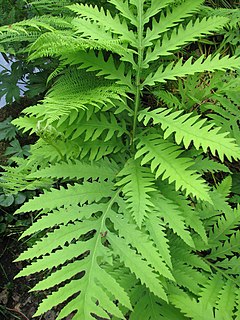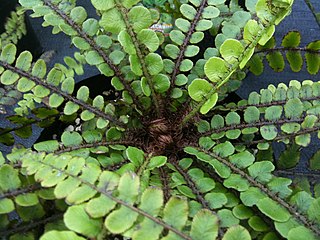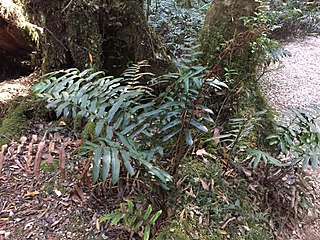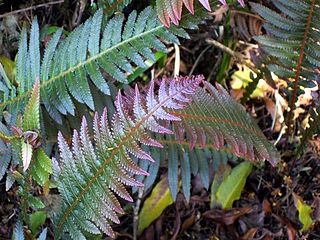
A frond is a large, divided leaf. In both common usage and botanical nomenclature, the leaves of ferns are referred to as fronds and some botanists restrict the term to this group. Other botanists allow the term frond to also apply to the large leaves of cycads and palms (Arecaceae). "Frond" is commonly used to identify a large, compound leaf, but if the term is used botanically to refer to the leaves of ferns and algae it may be applied to smaller and undivided leaves.

Asplenium platyneuron, commonly known as ebony spleenwort or brownstem spleenwort, is a fern native to North America east of the Rocky Mountains and to South Africa. It takes its common name from its dark, reddish-brown, glossy stipe and rachis, which bear a once-divided, pinnate leaf. The fertile fronds, which die off in the winter, are darker green and stand upright, while the sterile fronds are evergreen and lie flat on the ground. An auricle at the base of each pinna points towards the tip of the frond. The dimorphic fronds and alternate, rather than opposite, pinnae distinguish it from the similar black-stemmed spleenwort.

Dicksonia antarctica is a species of evergreen tree fern native to eastern Australia, ranging from south-east Queensland, coastal New South Wales and Victoria to Tasmania.

Onoclea sensibilis, the sensitive fern, also known as the bead fern, is a coarse-textured, medium to large-sized deciduous perennial fern. The name comes from the observation by early American settlers that it was very sensitive to frost, the fronds dying quickly when first touched by it. It is sometimes treated as the only species in Onoclea, but some authors do not consider the genus monotypic.

Cyathea cunninghamii, also known as the gully tree fern and slender tree fern, is a species of tree fern indigenous to New Zealand including North Island, South Island and Chatham Islands; also to Victoria, possibly New South Wales, southeastern Queensland and Tasmania in Australia. It grows in damp forest, often emerging from stream gullies and riverbanks. Brownsey noted that it has a lower tolerance for drought than other species of Cyathea. The erect trunk may be 20 m tall and is usually 6–15 cm in diameter, occasionally as much as 20 cm. Fronds are tri- to tetrapinnate and 3 m or more in length. The rachis and stipe are slender, black brown, warty and covered with brown scales. Sori occur along each side of the pinnule midvein and are covered by hood-like indusia. C. cunninghamii is an uncommon and slow-growing tree fern.
Cyathea recommutata is a species of tree fern native to the Malay Peninsula, central and southern Sumatra and Borneo, where it grows in acidic peaty or sandy soils in wet forest, as well as swamp forest, from sea level to an altitude of 1500 m. The trunk is erect and rarely taller than 3 m. Fronds are bipinnate and 1–2 m long. Characteristically of this species, the lowest pair of pinnae are usually reduced and occur towards the base of the stipe. The stipe itself is dark dark and bears dark, glossy basal scales with thin, fragile edges. Fertile pinnules are notably smaller than sterile ones. Sori occur near the fertile pinnule midvein and lack indusia.

Polystichum acrostichoides, commonly denominated Christmas fern, is a perennial, evergreen fern native to eastern North America, from Nova Scotia, Canada west to Minnesota and south to Florida and eastern Texas. It is one of the commonest ferns in eastern North America, being found in moist and shady habitats in woodlands, rocky slopes, and stream banks. The common name derives from the evergreen fronds which are often still green at Christmas in December.

The species Ceratopteris thalictroides is a fern species belonging to the genus Ceratopteris, one of only two genera of the Ceratopteridoideae subfamily of the family Pteridaceae.

Blechnum fluviatile is a fern known in the Māori language as kiwikiwi. A herbaceous plant, B. fluviatile is a "hard fern" of the genus Blechnum in the family Blechnaceae. It was identified by Patrick Brownsey in 1979. Other common names are star fern, creek fern, kawakawa and kiwakiwa.

Platycerium bifurcatum, the elkhorn fern or common staghorn fern, is a species of fern native to Java, New Guinea and southeastern Australia, in New South Wales, Queensland and on Lord Howe Island. It is a bracket epiphyte occurring in and near rainforests. Growing to 90 cm (35 in) tall by 80 cm (31 in) broad, it has heart-shaped sterile fronds 12–45 cm (5–18 in) long, and arching grey-green fertile fronds which are forked and strap-shaped, and grow up to 90 cm (35 in) long.

Blechnum wattsii or the hard water fern is a common terrestrial fern growing in rainforest and open forest. Often seen near creeks in much of south eastern Australia, including Victoria, Tasmania, South Australia, New South Wales and Queensland. The Blechnum wattsii was named for Reverend William Walter Watts (1856-1920). Reverend Watts was considered an authority on mosses and ferns and has more than 30 species named for him. Common names by which B. wattsii may be called are hard water fern - from its stiff leathery fronds, leech fern - as forest workers often encounter leaches while working in clusters of these ferns, hard hill fern - from the fern's habit and habitat, and red cabbage fern - from the bronze-pink colour of the young fronds resembling cooked red cabbage.

Blechnum cartilagineum is known as the gristle fern or soft water fern. It is a resilient and abundant fern growing in eastern Australia. Seen in rainforest and eucalyptus forest. New growth is often pink or reddish in colour.

Doodia aspera, commonly known as Prickly Rasp Fern, is a widespread and common plant, growing in eastern Australia. Often seen in rainforest margins or eucalyptus forest in Victoria, New South Wales and Queensland, it is a terrestrial fern with reddish new growth.

Pellaea falcata, the sickle fern, is a widespread and common plant, growing in eastern Australia. Often seen in on the coast and ranges in eucalyptus forest and rainforest. Occurring in Tasmania, Victoria, New South Wales and Queensland. Also occurring on Lord Howe Island. It prefers ample water when grown indoors,and can take very bright light but not full sun. Fronds usually 37 to 105 cm long. Fronds with between 27 and 65 leaflets, sometimes more. These pinnae have a short stalk or no stalk, oblong to narrow-oblong in shape. 22 to 56 mm long, 5 to 12 mm wide.

Asplenium bradleyi, commonly known as Bradley's spleenwort or cliff spleenwort, is a rare epipetric fern of east-central North America. Named after Professor Frank Howe Bradley, who first collected it in Tennessee, it may be found infrequently throughout much of the Appalachian Mountains, the Ozarks, and the Ouachita Mountains, growing in small crevices on exposed sandstone cliffs. The species originated as a hybrid between mountain spleenwort and ebony spleenwort ; A. bradleyi originated when that sterile diploid hybrid underwent chromosome doubling to become a fertile tetraploid, a phenomenon known as allopolyploidy. Studies indicate that the present population of Bradley's spleenwort arose from several independent doublings of sterile diploid hybrids. A. bradleyi can also form sterile hybrids with several other spleenworts.
Victoria, Australia contains approximately 32,000 hectares of temperate rainforest in various regions, which represents 0.14% of the State's total area. The areas with rainforest include: East Gippsland, Strzelecki Ranges, Wilsons Promontory, Central Highlands, and Otway Ranges. The rainforests vary between cool temperate, warm temperate, and mixed cool temperate.

Histiopteris incisa, the bat's wing fern, water fern or fern mata, is a common plant found in Australia, New Zealand and other islands in the south Pacific region. Usually found in moist areas, where it may form large colonies. The lowermost lobes of each pinnae have a bat wing like appearance, giving the fern its common name.

Lygodium japonicum is a species of fern that is known by the common names vine-like fern and Japanese climbing fern. It is native to eastern Asia, including Japan, Korea, southeastern Asia, and India, and eastern Australia. The fern is present in the southeastern United States and Puerto Rico as an introduced species.
Tasmania is home to 'Australia’s largest cool temperate rainforests... Most of Tasmania’s rainforests occur in the North-West and throughout the North East highlands. Cool temperate rainforests typically have a heavy rainfall, cool climate, favor high altitudes and have a limited availability of light.





















